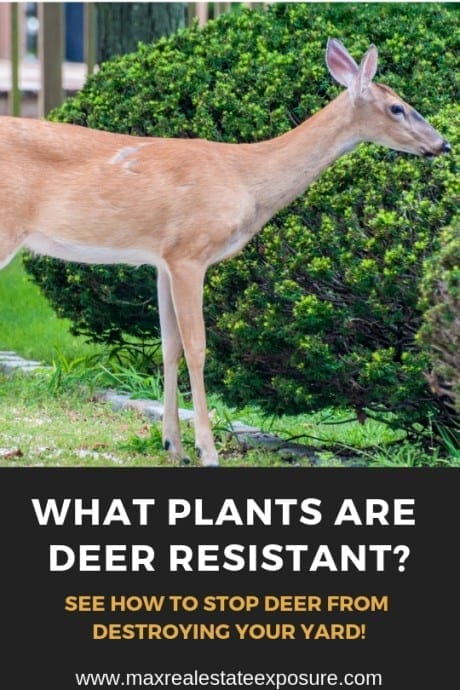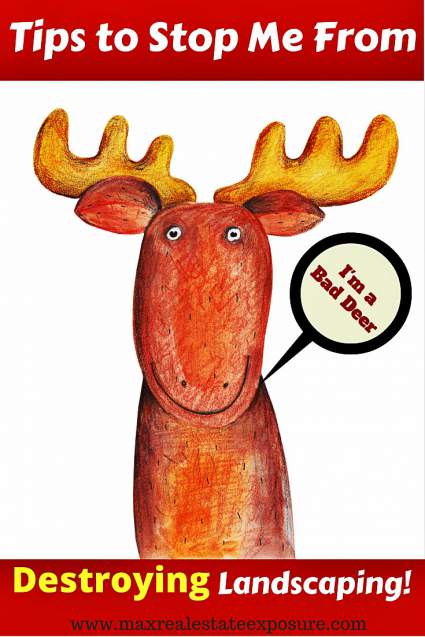Over the years, one of the questions prospective sellers have asked me is how do I stop deer from eating my plants? People ask, of course, because they want their yard to look its best.
Although they can be beautiful, deer can be surprisingly destructive to your landscape.
Considering how much time and money goes into your landscaping, it only makes sense to do what you can to keep the deer away.
Fortunately, there are proven ways of minimizing the damage deer do to your plants. It may take trial and error, but you can keep them away and enjoy a more complete and attractive landscape.
Providing helpful info on preventing deer from eating your plants was inspired by a home I was selling in Franklin, Massachusetts. Deer always ate the landscaping while the house was on the market.
The owner mentioned to me on a few occasions how he wished he knew how to prevent the deer from ruining the look of his yard.
Real Estate agents are constantly discussing improvements that will increase a home’s value, with landscaping being one of them.
It was easy to understand the client’s frustration with the deer eating all the hard work they had put into creating a beautiful yard.
Owning homes in multiple states and being a Realtor has put things in perspective on the importance of stopping deer from ruing your landscaping.
When you allow the deer to do as they please your home’s appearance will suffer. It can be especially disappointing when your home is listed for sale. Well, I will help you put an end to that!
Below are some tips to stop deer from destroying your flowers and plants!
Three Most Common Types Of Deer
Before learning how to prevent deer from eating plants, you should know a little bit about the different kinds of deer species. In the U.S., the three most common types of deer are:
White-Tailed Deer
White-tailed deer can be spotted quite quickly when running away from you, as their tails are held high, and you can see their white coloration. They are the smallest species among the significant types of deer. They are most often found from Southern Canada to South America.
Black-Tailed Deer
The black-tailed deer have more petite tails than their white-tailed cousins. Their tails are tipped in black. These deer types are often called the “Pacific Ghost.” These deer are most frequently found from Central California to Alaska. Their lives are usually spent roaming through brush and plantings in the Pacific Rain Forests.
There are two subspecies of blacktails, the Sitka blacktail (Odocoileus hemionus sitkensis) of the Alaskan and British Columbia coast and the more familiar Columbia blacktail (Odocoileus hemionus columbianus) occurring from central California north through coastal British Columbia.
Mule Deer
Mule deer are most notable for their size, which is much more significant than white-tailed or black-tailed deer. However, their tails are not substantial and are tipped in black. While mule deer are indigenous to North America, they are most often found West of the Missouri River.
While they can be beautiful creatures, looking at deer can create significant havoc with your plants and other landscaping. You may even feel sorry for them in a harsh winter as they look for a good food source.
If you want your land to look its best, however, come springtime, protective measures will be needed to make that happen.
Verify Deer Behavior In Your Area
 To combat the deer in your area effectively, you will need an idea of their patterns and behavior. Most importantly, you will need to know what they like to eat.
To combat the deer in your area effectively, you will need an idea of their patterns and behavior. Most importantly, you will need to know what they like to eat.
You can walk around your neighborhood and observe different landscapes and plants.
It is pretty easy to spot the ones that deer find tasty, as they will be stripped down and look much more miserable than the plants they avoid.
Please take note of the different plants and how the deer respond to them. One of the easiest ways to avoid deer destruction in your landscape is to plant things they don’t like and minimize the plants they like.
Talk To Your Local Garden Store About Deer Resistant Plants
When you pick out your plants for your landscape, you can ask the local gardening experts what plants the deer tend to avoid in your area.
Although deer will eat just about anything if there is enough pressure, such as from predators or weather conditions, they have their preferences. A local expert can tell you exactly what those are in your area.
Deers tend to go for new growth, preferring tender plants to more rigid materials. Deer also avoids more potent and spicy herbs, such as oregano, chives, lavender, rosemary, and thyme.
Deer-resistant plants include:
- Elderberry
- Barberry
- Oregon Grape
- Spruce
- Bleeding Heart
- Foxglove
- Rhododendron
- Iris
- Black-eyed Susan
- Heather
- Salal
The list of deer-resistant plants is much more extensive than this, but you can see some plants you can use that will be less likely to be eaten.
To achieve the best landscape, you must choose plants that will grow well in your area, so talking to local experts is the easiest way to plan your deer-resistance landscape.
Here is an incredible resource of deer-resistant plants. This is as complete as a list you will find. Use this as a guide for purchasing landscaping that will keep the deer out of your yard!
Ways To Deter Deer From Your Plants and Flowers
Below are eight more tips on how to keep deer from eating your plants and flowers. Use some or all of these tips to ensure the deer do not ravage your plants and garden this winter.
Avoid planting too many tasty treats.
The more delicious, ideal deer food you plant, the more you will have to fight them off using various methods.
Eliminating deer from your yard is virtually impossible if you are in an area popular with deer, so you must compromise what you plant.
Plant the plant’s deer love close to home.
Deer doesn’t want to get too close to people. Keeping the desirable plants close to the house allows you to watch them and run out if you see them being eaten.
Plant a border of strong-smelling perennials.
Deers follow their noses for food, so you can often trick them using the right plants. Planting a sufficient amount of strong-smelling plants, such as rosemary or lavender, can throw off the deer’s sense of smell and drive them away from your more desirable plants.
For those who love the ease with which perennials bloom year after year, here is a guide to deer-resistant perennials. These are great flower choices to keep the deer choosing your yard as their home base.
Make it uncomfortable with thorny foliage.
Deers are challenging but still vulnerable to sharp thorns and other unpleasant-feeling foliage. If you add these features near the plants that the deer like to eat, they may avoid them.
Make your delicious plants less visible.
If you make it harder to see your garden using bushes and trees that deer do not eat, the deer might not be as likely to venture into your yard.
Get a scarecrow.
Although you might not like how it looks, a scarecrow can effectively keep deer away. They are naturally timid animals so that a humanoid shape can be off-putting. Here is how to make a scarecrow to keep deer out of your landscaping.
Fence your landscape in.
Fencing is the most effective method for preventing deer from destroying your plants, though it can be expensive.
If you are willing to invest in a high fence of at least 8 feet or more, you should be able to repel deer from your garden. You will need to ensure no vulnerabilities in the barrier, with no significant gaps where the deer can squeeze through and a tall height they cannot jump over.
A fence should be at least 8 feet tall to prevent deer from jumping over it. Alternatively, plastic netting or floating row covers can protect plants for a minimal cost.
Consider commercial repellents.
Some commercial deer repellents and tools can be valuable for keeping deer from eating your landscaping. You can purchase a sensor that will spray a sprinkler at the intruders or buy a spray that smells quite bad, deterring the deer. These may or may not work in your situation, but they can be worth trying if other methods fail.
These are some of the best ways of preventing deer from eating plants and destroying the natural look of your landscaping.
If you are like me and hate the thought of winter, you could always pack up and head south, where the deer issues are not quite as prevalent! You would, of course, need the best ways to sell your house in the winter, where there are exceptional tips for selling this season. Either way, I wish you all the best in keeping these pesky critters out of your yard.
Prepare DIY Repellents to Stop Deer From Eating Your Plants
Additional Strategies to Repel
- Plant deer-resistant plants around the perimeter of your garden, such as lavender, marigolds, and garlic, to create a natural barrier.
- Use physical barriers like fencing or netting for protection, especially for young trees and high-value plants.
Utilizing Physical Barriers as a Deterrent
Additional Home Selling and Maintenance Articles Worth A Look
- How to winterize your property: See excellent tips on preparing your property for winter via the Rochester Real Estate Blog.
- How to prevent ice dams: Get sound advice via Massachusetts Real Estate Exposure on avoiding and removing icing issues at home.
- Making a home more appealing: Learn how to make potential buyers love your house via Selling Warner Robbins.
- Home features that improve value: See what amenities home buyers love to find in properties for sale via Cincinnati and Northern Kentucky Real Estate.
Use these additional resources for keeping up around your home. Whether you are selling now or sometime down the road, a well-maintained home is what many buyers expect. Keep your home value up by following sensible selling and maintenance advice.
About the Author: Bill Gassett, a nationally recognized leader in his field, provided information on stopping deer from eating plants and flowers. He is an expert in mortgages, financing, moving, home improvement, and general real estate.
Learn more about Bill Gassett and the publications he has been featured in. Bill can be reached via email at billgassett@remaxexec.com or by phone at 508-625-0191. Bill has helped people move in and out of Metrowest towns for the last 38+ years.
Are you thinking of selling your home? I am passionate about real estate and love sharing my marketing expertise!
I service Real Estate Sales in the following Metrowest MA towns: Ashland, Bellingham, Douglas, Framingham, Franklin, Grafton, Holliston, Hopkinton, Hopedale, Medway, Mendon, Milford, Millbury, Millville, Natick, Northborough, Northbridge, Shrewsbury, Southborough, Sutton, Wayland, Westborough, Whitinsville, Worcester, Upton, and Uxbridge MA.


 To help protect your garden from deer without resorting to harsh chemicals, here are several DIY repellent recipes that can be effective.
To help protect your garden from deer without resorting to harsh chemicals, here are several DIY repellent recipes that can be effective.